A Rib, a Snake and a Flood
This is the first lesson in the Literal Genesis series. In this series, we'll take a look at some of the evolutionary thinking and how that relates to or doesn't relate to scripture.
One thing I want to reaffirm as we go through this entire series, and I hope this sticks, is that we hold firmly to scripture, we hold loosely to theories. That won't be the last time you hear me say that. I'll say that quite often. You hold firmly to scripture, hold loosely to theories, because the theories made by human beings, they're flawed, they change all the time, they're fluid. So we want to be sure that we're not taking what should be something scriptural and trying to force it into a theory. That doesn't work. You'll be unhappy with that, trust me.
And I've titled this 'A Rib, A Snake, and A Flood', because as we think about the early writings of Genesis, particularly the first 11 chapters of Genesis, this seems to give Christians the most problems. When we read about the creation week, the temptation in the garden with the snake, and the worldwide flood, and all the way up to the tower of Babel, we find so many times Christians want to compromise and say, that couldn't really be history.
Well, hopefully throughout this series I'll give you some different ways of looking at these events in the scriptures, from a scientific point of view. What I don't want to do is give you the idea that for every supernatural miraculous event we have to come up with some kind of scientific explanation, that's not the goal. For example, when Jesus fed the 5,000 with just a small basket of food, do we think, well, how did that happen scientifically? No, we don't think that at all. So we don't need a scientific explanation for the supernatural events, it's not required.
And you can't separate the supernatural from the physical anyhow. So that's kind of what this series is about. Let's take some deep breaths and get that oxygen to the brain, and let's do some critical thinking.
Worldviews
We'll start off with talking about a worldview. What is a worldview? Very simply put, that's the lens by which you look through at the world, at how you examine the world, at how you investigate the world, and how you come up with your idea of how the world really is.
When it comes down to it, my personal opinion is there's really only two worldviews. One is that you view everything through the lens of scripture. Meaning, if I'm a Christian, this is the worldview that I want to adopt. If scripture touches on something, that's where I want to start. If I'm a scientist, for example, and I'm a geologist and I'm investigating the rock layers, then I want to know, does the Bible have anything to say about geology? Does it touch on the rock layers? And if it does, I really need to start my science there, or I may get wrong conclusions. I'll come up with everything all backwards and it won't make much sense. You always want to start with that as a Christian.
The other worldview is really just one that lacks God. Looking at the world, interpreting the world, the events, people, places, things without any scriptural context or without God at all. So those are the two different types of worldviews.
Which Worldview for Christians?
And again, I want to stress as Christians, we always want to strive to have a worldview that's based on the Bible, otherwise we will get things wrong. Jesus said,
If I told you earthly things, and you do not believe, how will you believe if I tell you heavenly things?
- John 3:12
And you may be wondering, well, what earthly things did Jesus say, or what earthly things does scripture have to talk about?
Well, there are plenty. How about we just go right back to Genesis 1 and talk about the creation week or the flood, these are physical events. And Jesus is telling us that if we're having a hard time believing these, if we want to compromise those, and try to fit in human-made theories where they really shouldn't be tried to fit in, then we may have a hard time believing spiritual things, and that's not what any of us want. So there are plenty of those things in scripture that we have as examples.
Why Compromise?
I often wonder why Christians want to compromise, particularly with the first 11 chapters of Genesis. Why do they want to take that and say it's not to be taken literally, it's not real history, it's allegorical or it's illusory, it's poetic? Why do they want to do this? Can I just make the suggestion that the only reason that a Christian might want to compromise that very straightforward historical reading is because they've been influenced by the theories of flawed humans, that's the only reason. That's the only reason we'd want to do that.
For example, it's not just in Genesis we read that God created the universe, all living things, and everything that is contained within in six days. We read that in Exodus 20:11, there's other references all throughout scripture.
So in the next lesson, we'll talk about this as well. When we start to compromise in one area of scripture, it's a snowball effect, and it just keeps going and going. And it's really difficult to recuperate. At some point your theology is so backwards and messed up, it's difficult to know what's true anymore.
1. Creation Account
So let's start with the creation account. What I picked for this first discussion is four areas in early Genesis history that a lot of Christians have trouble with, beginning with creation.
As always, what we want to do is start with the Bible. Now remember, our worldview is based on scripture. So we start with scripture, see if scripture has something to say about it, and then we go and we do our investigations from there.
Right off the bat, it's inescapable,
In the beginning, God created the heavens and the Earth.
- Genesis 1:1
Right upfront, God takes credit for everything that we see, everything that's been created.
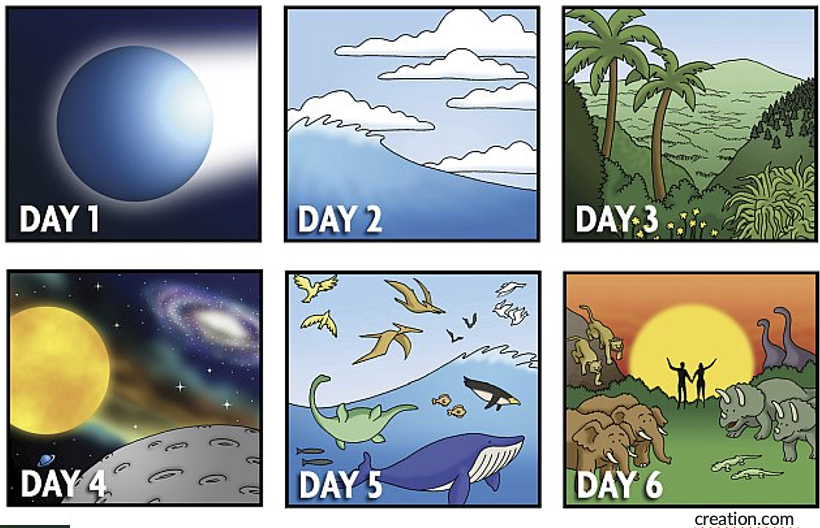
If we look at this simple picture above, there's a couple of things I want to point out. One is that it really is a straightforward reading in Genesis. He talks about evening and morning of day one, and evening and morning of day two. He tells us that on these days He did these things, and on these days He did other things. It's very, very specific. It's very easy to understand.
Now, if you're a Christian and you want to compromise with the alternative idea, and that is that there's a naturalistic explanation for everything we see, we don't need God, well, first of all, to leave God out of your explanation, that's not good. But I want to point out a few things here, and that is that you can not cram these ideas, these theories of flawed humans, and make them fit into this historical account.
Right off the bat, we have day one- the Earth. The other explanation for how things got here doesn't have the Earth until billions of years later, after the big bang, so that doesn't fit.
Look at day five, we've got birds and flying reptiles before day six, where there would have been land-dwelling dinosaurs. The alternative theory is that dinosaurs evolved into birds, so you can't have birds before dinosaurs. There's way more here than I want to get into right now. But just know that when you begin to compromise, things just start getting ugly pretty quickly. So you have this idea that God spoke, and it stood fast, God spoke, and it happened.
What's the alternative? That nothing exploded and produced everything. I really want to draw your attention to this word nothing. Never in my history on this Earth have I come across one word that has caused so much confusion as this word, nothing.
When we read the scientific literature, and it says that the singularity, this big bang, happened from nothing at all, what does nothing mean? It means no thing. It means not anything. It means nothing at all.
This is what we're left with as an alternative, that everything exploded out of nothing at all. Now you tell me, which is the most plausible explanation for how everything got here: That we have a transcendent God who's outside of space and time, in fact, He creates space and time and all matter at the moment of creation; or nothing at all exploded, and here we are, billions of years later?
We don't have to hang our heads down as Christians when we talk about our beginnings in Genesis. It's history and it's way better than the alternatives.
Now, there's lots of other things we can say about the big bang, we're not going to do that today. I just want to point out one thing. In fact, each of the things we'll talk about here, there's multiple areas we could explore, but I just want to talk about one thing for each of these four. I'm not the only one who feels this way.
"In my opinion, the observations speak a different language. They call for a different view of the universe. I believe that the big bang theory should be replaced, because it is no longer a valid theory."
- Halton Arp, Astronomer
Doctor Arp is not alone. There's lots of other scientists who feel the same way. These aren't scientists who are Christians. As far as I know, Halton Arp is not a Christian, but he's had enough of this idea of funding going to the big bang, which makes no sense and is full of flaws. You'll find quotes like this all over if you take time to look.
2. Eve from a Rib
I have been personally ridiculed for this one on more than one occasion. If you can picture somebody snickering, saying, "Hey, hey, go ask him where he thinks the first woman came from, he thinks it came from a rib from the first man," and all the laughter appears. It just seems like a childhood story, doesn't it? It just doesn't seem real.
Well, I want to show you here in a few moments that there's scientific evidence to support that this could actually happen that way. Again, not that we need scientific evidence to support what we read in scripture, but sometimes it's really nice, isn't it? Okay, so as always, we go back to scripture. Our worldview is based on scripture, so what does the scripture have to say about the first woman?
And the rib that the Lord God had taken from the man he made into a woman.
- Genesis 2:22
There are so many things here that we could talk about with this rib and things that it symbolizes. But again, I just want to stick to one thing. Could God have made Eve out of nothing at all, just with his voice? Absolutely. Yet, He takes the time to tell us that He caused Adam to go into a sleep, which is the first anesthesiology, if you want to look at it that way, and He performs a surgery on Adam, and He takes a rib and He fashions Eve out of that rib. He takes the time to tell us these things. I think it's important that He does. Instead of just saying, oh, and by the way, He made a woman for Adam. He gives us just enough detail that's very intriguing.
Periosteum

So the first thing about a rib bone we need to talk about is something that wraps around nearly every bone in our bodies, it's called the periosteum. It's just like a sheath, it's like a very thin covering on almost every bone that we have. And the periosteum is really interesting, particularly as it pertains to ribs. There's an outer layer and an inner layer. The outer layer is very fibrous, very tough. Then the inner layer is more cellular, more spongy. And it has some responsibility in bone growth and bone repair. So when you break a bone in your body, it's the periosteum that says, oh, we got a break, and it sends very important cells into where that break is, osteoblasts, so that the bone can begin repairing itself.
It is also very important in bone growth. This periosteum, the inner layer is very, very thick at birth and then it thins progressively as we age, which is one explanation as to why bones take a little longer to heal as we get older. This is one reason why- that periosteum gets a little thin.
Now the periosteum, when it comes to the rib, will do something absolutely amazing. If you take a rib out of a person and you leave that sheath intact, you leave the periosteum intact, it'll initiate bone growth, and a whole new rib will grow in its place. That's not something a lot of people know. I've talked to MDs about this, and there's many that didn't even know this until they began to do the research, but it's true. And in fact, it's the only bone in the body that we know of that if you take it out and you leave the periosteum intact, that the bone will grow right back in the place of where you took the bone.
Isn't that amazing? Do you think God knew that when He took the rib from Adam? Of course He did. He designed Adam. He knew exactly what He was doing. And it doesn't take very long, not years, but on the order of months.
So Adam didn't miss that rib for very long. He grew that back through the process of the periosteum and it only took a matter of months. So he still had 12 pairs of ribs. Women have 12 pairs of ribs. Guys aren't missing a rib, all right. Let's get that right. We're not missing a rib. That's not how it works. Okay, so God took the rib and Adam wouldn't have been without it for very long. Well, what else could God have done with this rib? Why was it important to take this rib?
The next thing I'll point out is that there are many important cell types inside of a rib, in the bone marrow, there's stem cells. You've probably heard that in the news over the last 10-15 years. There's not just one type, but there's multipotent, pluripotent, unipotent, there's lots of different types of stem cells. Well, what can we do with a stem cell? Hold that thought.
Chromosomes
Every human being on the planet, usually, has 23 pairs of chromosomes. If you have one less or one more, that causes health issues, so 23 is the healthy number, 23 pairs. Twenty-two of those 23 are identical in men and women, they're the same. But that 23rd chromosome, that's different, that's what determines the gender. And in males, as you see here, that's called the XY chromosome, and females, it's two Xs, it's XX.
Now this is kind of interesting to me that Adam, having an X chromosome, would have had all the genetic material required to make a woman. Isn't that interesting? All the genetic material is there in that XY chromosome to make a woman. So with the XY chromosomes, there's something else that we need to understand. Let's say God took a cell, one of the stem cells, from the rib, and he was going to fashion Eve from it. Well, it's an XY, that's not the right chromosome. Did you know that if you take the XY chromosome and you strip the Y away, that the X will replicate itself and you'll end up with XX. What's XX? That's what the female needs, two X chromosomes. If you strip away the Y, the X will replicate itself, and you end up with XX.

So let's say, I'm not saying God did it this way, I have no idea, but this is scientifically possible that God would have taken one of those stem cells, stripped away the Y, the X would have replicated itself, and now he has a nucleus with the right chromosomes to make a woman. What did he have to do from there? Again, I'm not saying He did it this way, I have no idea. Scientifically, this is possible. You take that nucleus from Adam's cell, the one that now has the XX for the 23rd chromosome, and you put it in what's called a nucleated egg cell, so an egg cell without its nucleus, you put it right there in the nucleus, and what will happen is you'll get a female that develops from that cell.
This is not science fiction. This has been done with sheep, it's been done with mice. In fact, they've even changed the sex of an animal inside of the embryo while it's developing using this procedure. It's very, very interesting, but again, from a scientific point of view, the rib may have been the best possible bone for God to use. It may have been the only possible bone for God to use to do this. Very fascinating. So again, this is a theory. What do we say about theories? We hold firmly to
scripture, we hold loosely to theories. I'm not married to this theory at all. I'm just presenting it as a scientific way that God could have used. There's lots of other questions this may open up for you, but every theory has lots of questions, right?
3. Snake with Legs
Our Biblical worldview demands that we start with scripture. What does the scripture have to say about snakes and this idea that they may have had legs?
Then the Lord God said to the serpent, 'Because you have done this, cursed are you, more than all the livestock, and more than any animal of the field. On your belly you shall go, and dust you shall eat all the days of your life.'
- Genesis 3:14
Now, when I read this, I picture before this happened, that snakes had legs. And for many years Christians have been ridiculed about this idea of snakes with legs. Okay, well, maybe I'm missing the elephant in the room. The snake talked, right? Well, Kim, are you going to address that? I get asked this question a lot. No, I'm not going to address that. Why? It is supernatural for an animal to talk. That's outside of nature. I don't need to come up with some kind of scientific explanation for something that's supernatural. I'm not even going to try to go there. By the way, how many animals in the Bible, that we know of, talked? Just two: the serpent in the garden, and Balaam's donkey. I don't need to come up with scientific evidences for those, but I will address this idea about a snake having legs.
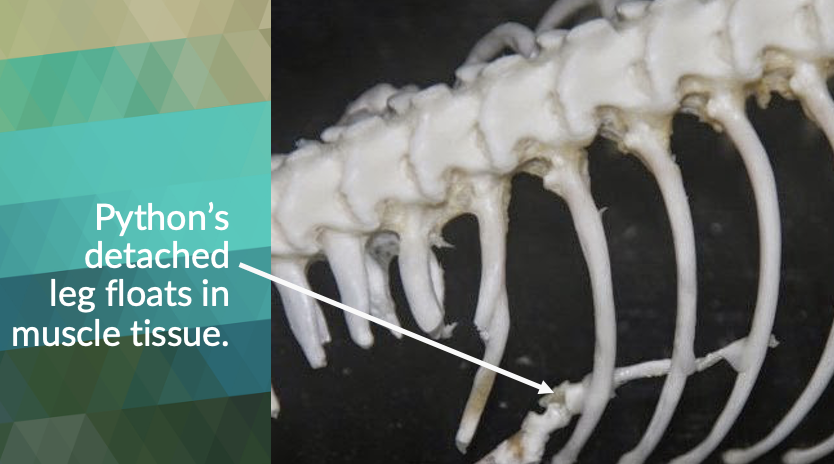
Did you know that pythons actually have legs, kind of towards the rear of the skeleton where the hips should be? Now they don't have hips, but they have two legs, and they're just floating in muscle tissue. They have legs, they're just not on the outside of the body, and they have nothing to connect to. Pythons aren't the only snakes that have these floating legs, but they're probably the most famous ones that people refer to.
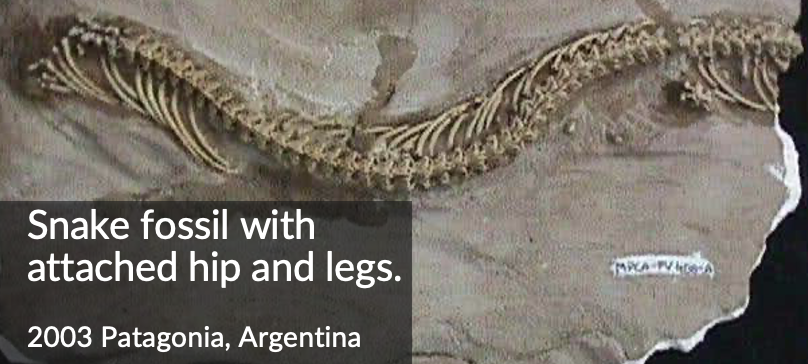
We can probably do even a little better than this. A python has these inside legs, maybe that's a part of the curse, I don't know. Was it a python in the garden? I don't know. But this is interesting. In 2003, in Argentina, scientists found a fossilized snake that had a hip and it had legs. Something people don't realize is that when they make fun of Christians for this idea, they say snakes never had legs, well, they haven't done their research.
I've been doing this a long time, 20 years, and what I've come to find out is you learn a lot in 20 years, but everything you learn, you realize just how much more there is to learn. You can never know it all.
But this is interesting, because scientists still believe that snakes used to have legs. In fact, they think snakes evolved from a sea creature called a mosasaur, and they had these legs in the ocean. They lost their legs and then they migrated on the land.
However, this is just to show you how fluid some of these theories are, this is a land snake. It's not a marine snake, and yet it had legs, it had a hip bone. So their theory needs to be changed. And this is why we hold firmly to scripture, we hold loosely to theories, because theories change all the time.
"In one fell swoop, this new fossil kind of casts doubt on the aquatic hypothesis."
- Blair Hedges,
Evolutionary Biologist
Pennsylvania State University
What I just explained to you- that snakes had legs in the sea, they lost them before they came on land. Well, that couldn't have happened because here's a land snake that had legs. Very fluid, these theories of evolution. Why is that? Because we have no direct observation into the past. All we have is fossil evidence, and then we make inferences on those fossils based on our, you guessed it, our worldview.
4. Global Flood
This is perhaps the biggest one where Christians may be hanging their head down a little bit or feeling a little strange about talking about. You don't need to do that. There's so much evidence. You'd think if the world was covered with water, there would be evidence. There's plenty of evidence. We're going to look at one thing today, that should be enough. Again, we go to scripture, our worldview:
"For after seven more days, I will send rain on the Earth for 40 days and 40 nights, and I will wipe out from the face of the land every living thing that I have made."
- Genesis 7:4
This is a catastrophic event. There must be some kind of evidence that was left behind.
Foraminifera
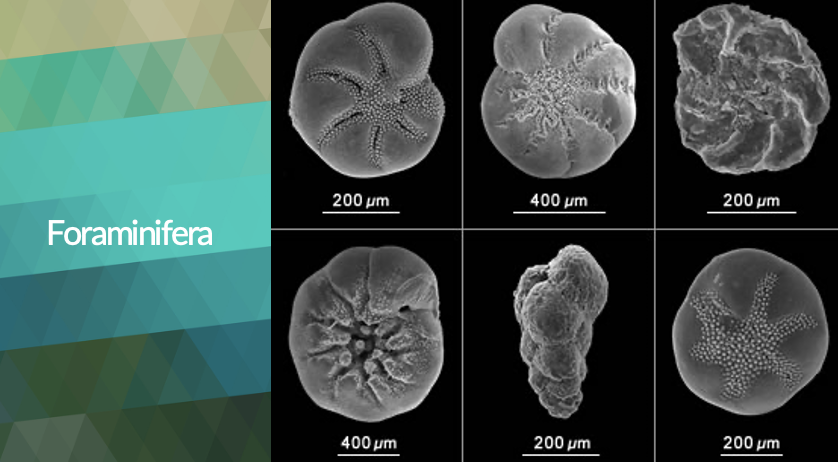
And to begin looking at this evidence, we would need to understand about a tiny, little creature called foraminifera. These are very, very small single-celled organisms that create a calcium carbonate shell, this is what they live in. And you can see from the pictures here, these shells have lots of different designs, some of them are absolutely stunning.
But take note of the sizes here. We're in micrometers here. How big is a micrometer? Well, it's 1000th of a millimeter. How big is a millimeter? It's about the thickness of a dime. So if you hold a dime in your hand, you look at the edge and think about something that's 1000 times smaller than the height of that edge, now you're talking about foraminifera.
These foraminifera live in all parts of the oceans, all oceans of the world, and all kinds of depths, anywhere from the first 300 feet down to 15,000 feet, they're everywhere. There are trillions of these things in the oceans. and the idea is that when they die, because some of them have a very short life span, sometimes it's days, some of them live for years, and everything in between, but they slowly fall and they make their way down to the ocean bottom, where they become ooze. And they accumulate over time to develop what's called white chalk, or white limestone, if you will. This is a very slow process. When we look at this process today, we think it happens at about the rate of 0.008 inches a year. So what does that mean? That means in a thousand years you would have eight inches of this sediment buildup. It's very, very slow. Below is a picture of what some of this white chalk looks like.
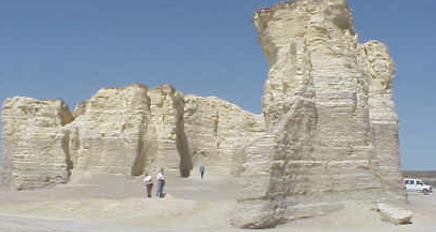
You may be thinking right now, the White Cliffs of Dover, that's another white chalk geologic form that we see. It's very beautiful. And so here, this one happens to be in the USA, this white chalk that's stacked up here. And this white chalk is found on a lot of different continents and countries: North America, Europe, Ireland, Poland, Germany, Turkey, Israel, and Australia. In the US, it's found from Nebraska to Texas, and from Alabama to Colorado. There are big geographic areas of this white chalk. And it only forms as marine sediments. In other words, it only forms in water. And when we find these chalk layers in all these different places around the globe, they have the same type of fossils, and we see the same types of layers above and below them.
This is a strong indication that the entire Earth was underwater at the same time. This is different than the gradualistic, naturalistic explanation that you'll hear today in textbooks, that different parts of the US were underwater, that different parts of Europe were underwater, and all at different times. It doesn't make sense. This is very clear evidence, to me, that the entire planet was underwater at the same time to form these same sediments, for the same fossils, in the same relative position.
So in this sediment, the picture that I've just shown, we find some very interesting mix of fossils: 6.5 foot tall birds, that's a huge bird, right? We're not talking about an ostrich or an emu, or anything like that. We're talking about just a normal bird; a 20 foot long fish. For your fishermen, you'd love to catch something like that; 30 foot dinosaurs; 13 foot wide oysters. Imagine the pearl that might be inside some of those things; we find mosasaurs nearly 50 feet long, and plesiosaurs. All these different things in the same sediments.
What do they have in common? I think I just gave it away. They're found in Kansas, in the same sediment, the same chalky sediment in Kansas. Now think about this: I'm always telling people to be critical thinkers, ask questions, be curious, no matter what you're being taught, ask the questions. If you don't understand something, something doesn't make sense, ask the questions. And particularly when it comes to evolutionary ideology, we need to ask these questions. And the question I would ask here is: since when do land-dwelling dinosaurs, air-flying birds, fish- when did these live in the same environment to be buried together at the same time? Well, the answer is that they didn't. They don't live in the same environments.
Something catastrophic had to come along to bury these things together where they lived. If we take just one example here, that 6.5 foot tall bird that I mentioned- below is a picture of the fossil that was found- it would take 10,000 years just to bury this bird.
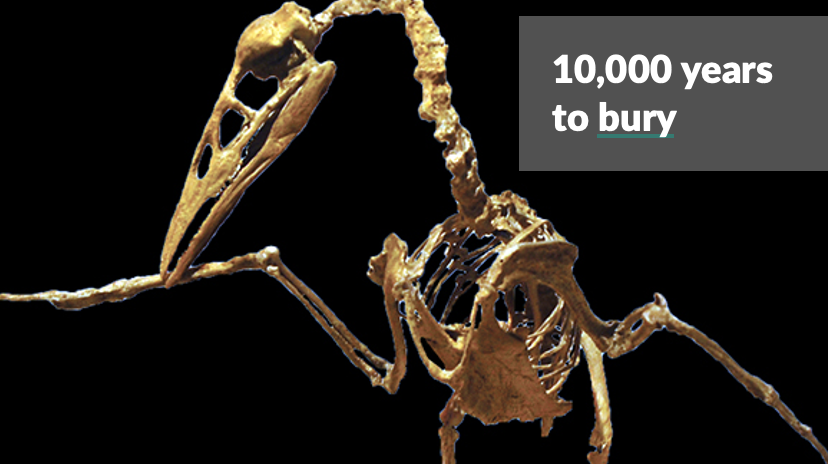
And some of these sediments of chalk are thousands of feet in thickness- very thick. Imagine how long it would take at 0.008 inches a year to build this sediment up. However, you can't slowly bury something organic at that rate, especially in water, and it not completely rot or dissolve away within the first year, or even less. It wouldn't even take a year. Yet we're to believe that these things were somehow buried together at an unimaginably slow rate, and we still have them preserved, almost perfectly in many cases. That doesn't make sense. So we need to ask the critical questions.
Is there another explanation? Well, my worldview as a Christian demands that I look at this geology in light of the flood. Not that every rock was made during the flood, but we have so many fossils to look at, and that's another evidence we'll talk about later, that it just makes sense that this was catastrophic.
Now, whenever I have quotes like this, I'll point out whether they're made by a Christian source or a secular source, non-Christian source. And so far, all these quotes have not been from Christian scientists.
"We are talking about a time, when if you were looking at the Earth from space, you would hardly see any land mass at all. It would have almost been an ocean world."
- Michael Tice,
Geobiology and Sedimentary Geology
Texas A&M, 2009
When we go to the museums, when we open up the textbooks, when our kids are learning about these things in school, they're not learning this. What they're learning is different floods, different regions, long, huge eons of time. When in fact, a sedimentary geologist says, "No, looking back at Earth's history, everything must have almost been underwater at the same time." Isn't that amazing? What does that sound like to you? That doesn't sound like what we're typically taught.
"However, some recent studies suggest that water may have covered Earth's entire surface for some 200 million years before the continents emerged."
- Tom Garrison,
Essentials of Oceanography
University of Southern California, 2013
So here's a scientist with the idea that the entire Earth was covered with water at the same time. Now, if you read the paper, you'll find he's- I don't think he's right about the timeframe, because of my Biblical worldview, I have to look at this in a different way, but the idea is that here's a scientist that's not a Christian who says the entire Earth must've been underwater at the same time.
When we're ridiculed about this global flood, we don't have to go very far to show that there's scientific evidence. There are scientists that are in line with the idea of the Earth being covered with water. I'm not saying they believe in the flood of Genesis, that's a separate matter.
Why so white?

Another question that we may want to ask about this white chalk, especially here- this is the White Cliffs of Dover- why is it so white? Think about this, think about the slow accumulation rate- very, very slow, on the bottom of the ocean floor, where everything eventually falls and makes its way down to the bottom, right? All the organisms that die float down there.
We have dust from space that makes its way down there. The sediments from the continents get washed down there. How do we have such thick white sediments that don't have other things mixed in, don't have other types of mud mixed in with it? Especially if some of these layers took 40 million years to accumulate, why are there no other types of sediments in here? Does that even make sense? That doesn't make sense.
What does make sense is rapid deposition, that these layers were laid down very, very quickly in the flood of Genesis. We'll talk more about that when we get to the flood of Genesis. Now here's a Christian scientist, geologist, I couldn't have worded any better, so this is why I want to use this quote, he says,
"Indeed, the purity of these thick chalk beds worldwide also testifies to their catastrophic deposition from enormous explosively generated blooms, since during protracted deposition over supposed millions of years, it's straining the credulity to expect that such purity would be maintained without contaminating events depositing other types of sediments."
- Andrew Snelling
Geologist
Now, of course, scientists who are very educated like to use words that we don't use in everyday speech, but this is what he's saying: He says, it's beyond belief to expect that the slow and gradual ideas of this sediment building up could maintain its purity, and be so white, and not have any other contaminants mixed in with it. I agree, 100%.
Now, going back to scripture, I think this is our better explanation, in Genesis 7:19-20,
All the high mountains everywhere under the heavens were covered. The water prevailed 15 cubits higher, and the mountains were covered.
- Genesis 7:19-20
There was no land visible. If you were to look at it from space, as we've seen from the one scientist a few minutes ago, this is what we would have seen, a world underwater, the entire globe. That makes sense to me.
Genesis is History
So in summary, when we read these things, I just picked four things today, we'll go into further detail about some of these. We'll look at DNA in upcoming lessons. We'll talk about the evolutionary theory. We'll really drill down and go into some details and see if science supports one idea or the other. Remember, science doesn't say anything. Scientists are the ones who vocalize things. Science is something that we each observe and we come up with our own conclusions.
So we don't have to hang our head about the creation, or about the fact that Eve was fashioned from Adam's rib, or snakes used to have legs, or the global flood. We have evidence all around us to support scripture every day.
I'll say it one more time: we hold firmly to scripture, we hold loosely to theories. Theories come and go, they're fluid. They change all the time. The Bible never changes.



